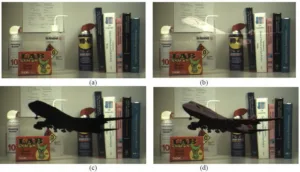While all the other sessions involved oral presentations, the poster session involved only poster presentations. The one poster session was held Thursday afternoon and followed Session 65. The authors of the papers are available for one-on-one discussions of their work. Since poster papers are often highly technical and of limited general interest, this one-on-one approach works quite well.
There were a total of 241 poster papers in the session and eight of them related directly to AR/VR. (P-102, P-103, P-104, P-105, P-218, P-219L, P-220L and P-226L.)
P-102 titled “Optical Design for a See-Through Head-Mounted Display with High Visibility” from National Chiao Tung University described a more efficient waveguide plate for combining real and virtual images.
P-103 titled “Optimization of Field of View and Color Uniformity in a Holographic Waveguide Display” from Southeast University, Nanjing, also described an improved waveguide plate for see-through AR displays.
P-104 titled “Holographic See-through AR Display with Zero-order Eliminated” from Shanghai Jiao Tong University described a third improved waveguide plate for see-through AR displays.
P-105 titled “Sensor-based Latency Reduction Method for Virtual Reality Head Mounted Display” described a method for system latency reduction by using a motion prediction algorithm.
P-218 titled “An Approach to Reduce VR Sickness by Content Based Field of View Processing” described a method to reduce VR sickness by reducing the FOW. This is closely related to the material Taesung Kim, VP at the Samsung Mobile Communications group, presented at his talk in the AR/VR business conference, Session III.
P-219L titled “A Digitally Switchable Multi-focal lens Using Freeform Optics for Wearable Displays” from the University of Arizona discussed a variable focal length lens to correct the vergence/accommodation problem in VR displays or the accommodation problem in AR displays.
P-220L titled “Demonstration of an Occlusion-Capable Optical See-Through Head-Mounted Display” from the University of Arizona described another optical design that allows occlusion of real objects by virtual objects. While the optical design was different from the one used in Paper 46.4 by Disney Research, the goal was the same. The advantage of the U. of Arizona design over the Disney design is that, conceivably, the U. of Arizona design could be made compact enough for use in a HMD.
(A) Real background scene (B) Virtual object without occlusion, (C) Occlusion mask, (D) Virtual object superimposed onto occlusion. (Image: U. of Arizona)
P-226L was titled “The Optical Design of Head-mounted Display System Based on Computer Generated Holography” from National Taiwan University was similar to the design given in Paper 51.1 from the Beijing Institute of Technology. Both of these designs are intended to address the vergence/accommodation problem.

